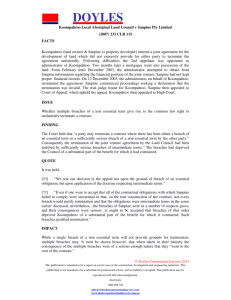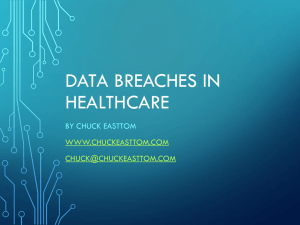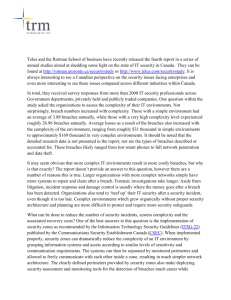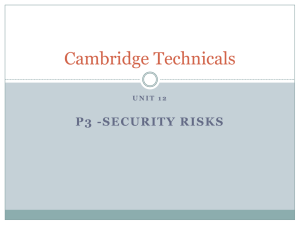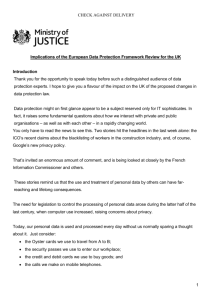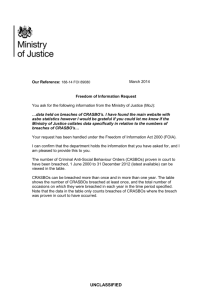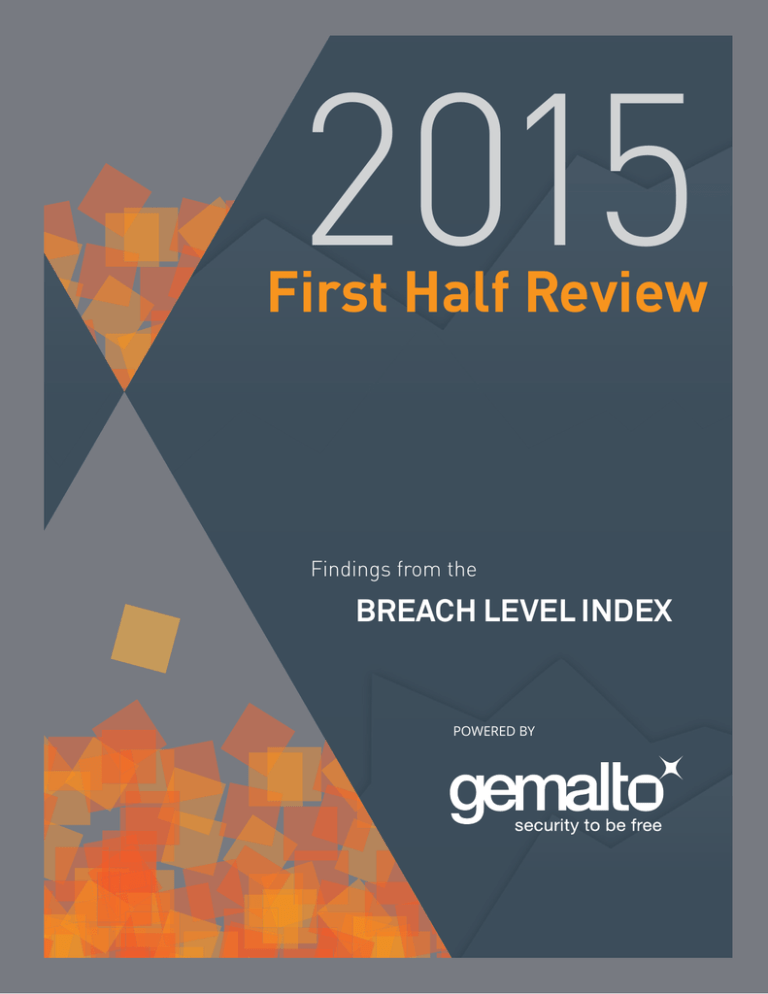
2015
First Half Review
Findings from the
BREACH LEVEL INDEX
POWERED BY
More and more organizations
are accepting the fact that,
despite their best efforts,
security breaches are
unavoidable.
BREACH LEVEL INDEX
THE NUMBERS
RECORDS BREACHED IN FIRST HALF OF 2015
NUMBER OF BREACH INCIDENTS
TOP 10 BREACHES
PERCENTAGE OF TOTAL RECORDS
82%
PERCENTAGE OF BREACHES
WHERE NUMBER OF COMPROMISED
RECORDS WAS UNKNOWN
50%
DATA RECORDS WERE LOST OR STOLEN WITH THE FOLLOWING FREQUENCY
245,919,393
888
EVERY
DAY
1,358,671
EVERY
HOUR
56,611
EVERY
MINUTE
943
EVERY
SECOND
16
INTRODUCTION
2015
FIRST HALF REVIEW
The first six months of 2015
A more dramatic decline was in
Other notable breaches in the
demonstrated that hackers
the number of breached records
analysis period included a breach
continue to get past conventional
which fell by 40% from the 414.8
of 21 million records at the U.S.
perimeter security with relative
million records breached in the
Office of Personnel Management,
ease, targeting nearly every
first half of last year. There was
with a Breach Level Index score
industry and executing several
an even greater drop (61%) in
of 9.7; a 50 million record breach
high profile data breaches
the number of breached records
at Turkey’s General Directorate
that scored tens of millions of
compared with the second half
of Population and Citizenship
data records each. And, while
of 2014, which saw a total of
Affairs with a score of 9.3; and
Identity Theft remains one of the
626.4 million records exposed.
a 20 million record breach at
leading types of data breaches,
Russia’s Topface with a score
the first half of 2015 has shown
One notable statistic is that for
of 9.2. The top 10 breaches
a shift in attack targets. For
nearly 50% of the reported first
accounted for 82% of all
example, data records stolen
half 2015 data breaches, the total
compromised records in the
from state-sponsored attacks
number of data records that were
first half of the year.
rose dramatically compared to
compromised is unknown.
previous years and healthcare
and government overtook
Large, headline-grabbing data
To create the Breach Level
retail as the major sectors
breaches continue to expose
Index, Gemalto gathers
under siege with the number of
massive amounts of stolen
extensive information about
compromised data records.
records. The biggest breach in the
data breaches worldwide, using
first half of this year, which scored
sources including Internet
a 10 on the Breach Level Index
searches, news articles and
magnitude scale, was an identity
analyses, and other resources.
The 2015 First Half
Review Key Findings
According to the latest findings of
theft attack on Anthem Insurance
the Breach Level Index produced
that exposed 78.8 million records.
The data is aggregated into
by digital security company
That attack represented one third
the Index where it is analyzed
Gemalto, 888 data breaches
(32%) of the total records exposed
according to the number of
occurred in the first half of 2015,
in the first half of 2015, and was
breaches and data records lost
compromising 245.9 million
highly publicized in part because it
and categorized by industry,
records worldwide. The number
represented the first major
type of breach, source of breach,
of breaches was relatively flat
state-sponsored cyber-attack
and tallied by country or region.
compared with the last six months
of several that occured in 2015.
of 2014 (892) but increased by
10% compared to the 803 data
breaches in first half of 2014.
3
BREACH LEVEL INDEX
NOTABLE DATA BREACHES
Anthem
Insurance
Score: 10.0
Records: 78,800,000
The U.S. based health insurance provider was hit with a state-sponsored,
identity theft breach in February 2015. Criminal hackers broke into the firm’s
servers and stole 78.8 million records that contain personally identifiable
information. According to Anthem, the data breach extended into multiple brands
that the company uses to market its healthcare plans including: Anthem Blue
Cross, Anthem Blue Cross and Blue Shield, Blue Cross and Blue Shield of Georgia,
Empire Blue Cross and Blue Shield, Amerigroup, Caremore, and UniCare.
General Directorate
of Population and
Citizenship Affairs
malicious outsider that resulted in the theft of 50 million records.
According to the Presidency’s State Audit Institution, the servers of the
Score: 9.9
Records: 50,000,000
administration’s website were easily breached and information about citizens
U.S. Office of
Personnel
Management (OPM)
In June 2015, the OPM was the target of a data breach that involved 21 million
was stolen.
records. This was a state-sponsored identity theft attack which has been
described by federal officials as one of the largest breaches of government data
Score: 9.6
Records: 21,000,000
in the history of the U.S. Information targeted in the breach included personally
Topface
This Russia-based online dating service experienced an account access
Score: 9.2
Records: 20,000,000
According to a Bloomberg report, the stolen information included the user
Gaana.com /
Times Internet
Score: 8.9
Records: 10,000,000
4
The Turkish government agency suffered an identity theft attack from a
identifiable information such as Social Security numbers, names, dates and places
of birth, and addresses.
breach by a malicious outsider that resulted in the theft of 20 million records.
names and e-mail addresses of 20 million visitors to the site.
One of India’s most popular music streaming services was hit with an identity
theft attack by a malicious outsider that affected 10 million records.
According to The Hacker News, the records stolen included user names,
email addresses, passwords, birthdates, and other personal information.
TOP SCORING
BREACHES
2015
FIRST HALF REVIEW
The Breach Level Index score, which rates the severity of a data breach, is based on factors such as total number
of records breached, type of data in the records, source of the breach, and how the information was used. A score
of 1 to 2.9 is minimal risk, 3 to 4.9 is moderate, 5 to 6.9 is critical, 7 to 8.9 is severe, and 9 to 10 is catastrophic.
The scale shows that not all data breaches have the same impact on organizations.
ORGANIZATION
RECORDS
ANTHEM INSURANCE COMPANIES
(ANTHEM BLUE CROSS) (U.S.)
78,800,000
GENERAL DIRECTORATE OF POPULATION AND
CITIZENSHIP AFFAIRS/THE GENERAL DIRECTORATE
OF LAND REGISTRY AND CADASTER (TURKEY)
50,000,000
U.S. OFFICE OF PERSONNEL MANAGEMENT (U.S.)
21,000,000
TOPFACE (RUSSIA)
20,000,000
GAANA.COM / TIMES INTERNET (PAKISTAN)
10,000,000
RAKUTEN AND LINE CORP ( JAPAN)
7,850,000
TALKTALK (U.K.)
4,000,000
MEDICAL INFORMATICS ENGINEERING (U.S.)
3,900,000
ADULT FRIENDFINDER (U.S.)
3,867,997
REGISTER.COM (U.S.)
1,400,000
SAUDI ARABIA GOVERNMENT (SAUDI ARABIA)
1,000,000
TYPE
IDENTITY
THEFT
IDENTITY
THEFT
IDENTITY
THEFT
ACCOUNT
ACCESS
IDENTITY
THEFT
ACCOUNT
ACCESS
IDENTITY
THEFT
IDENTITY
THEFT
EXISTENTIAL
DATA
EXISTENTIAL
DATA
EXISTENTIAL
DATA
INDUSTRY
SCORE
HEALTHCARE
10.0
GOVERNMENT
9.9
GOVERNMENT
9.6
TECHNOLOGY
9.2
RETAIL
8.9
RETAIL
8.8
OTHER
8.8
HEALTHCARE
8.8
OTHER
8.6
TECHNOLOGY
8.5
GOVERNMENT
8.4
5
BREACH LEVEL INDEX
DATA BREACHES
BY SOURCE
The leading source of data
five source types are malicious
from first half of 2013 (93.2%), the
breaches in the first half of
insiders (107 breaches for 12.0%),
second half of 2013 (96.3%), and
2015 continues to be malicious
hacktivists (19 breaches for 2.5%),
the first half of 2014 (71.8%). It
outsiders, who are responsible for
and state sponsored (17 breaches
was similar to the 42% share in
546 of the breaches in this period
for 2.2%).
the second half of last year, which
and comprise 61.5% of the total.
may indicate that records lost due
to outsiders has risen steadily
Compromised
Data Records
since the first half of 2013 when
In terms of compromised data
it accounted for only 52%.
records, malicious outsiders took
The next highest source of data
the top spot with 114.5 million
records lost was state-sponsored
Accidental loss is the next highest
stolen. This accounted for nearly
attacks with 101.5 million (41.3%).
source of data breaches. At 197,
half of all the records exposed
That was a significant increase
accidental loss accounts for 22.2%
in breaches during the period
from any previous period since
of all data breaches in the first
(46.6%). It’s notable that the
2013. For example, in 2013 and
half of 2015. Rounding out the top
share was down considerably
2014, the amount of data records
The share of attacks attributed
to breaches by malicious outsiders
have leveled off.
affected by state-sponsored
breaches was negligible and
NUMBER OF BREACH INCIDENTS
MALICIOUS OUTSIDER
BY SOURCE
HACKTIVIST
records in the second half of 2014.
Other sources of records theft in
first half of 2015 were accidental
ACCIDENTAL LOSS
MALICIOUS INSIDER
garnered a share of just 1.1% of all
2%
12%
loss (28.6 million for 11.6%),
2%
malicious insiders (784,000 for
0.3%), and hacktivists (562,000
for 0.2%). The number of records
affected by accidental loss dropped
STATE
SPONSORED
dramatically from the second half
22%
of 2014, when it was 305.2 million
62%
for 48.7%. Similarly, the amount of
records lost because of malicious
insiders has decreased sharply
from 106.2 million (25.6%) in
6
the first half of 2014 and 52.9
million (8.5%) in the second
half of that year.
2015
DATA BREACHES
BY SOURCE OVER TIME
NUMBER
OF BREACH
INCIDENTS
BY SOURCE
OVER TIME
500
400
300
200
100
H1 2013
H2 2013
SOURCE
NUMBER OF
RECORDS
BREACHED
BY SOURCE
OVER TIME
FIRST HALF REVIEW
H1 2014
H2 2014
H1 2015
H1 2013
H2 2013
H1 2014
H2 2014
H1 2015
Malicious Outsider
335
314
465
470
546
Accidental Loss
159
140
189
216
197
Malicious Insider
114
78
125
153
107
Hacktivist
21
8
4
15
19
State Sponsored
3
10
20
40
17
400,000,000
300,000,000
200,000,000
100,000,000
H1 2013
H2 2013
H1 2014
H2 2014
SOURCE
H1 2013
H2 2013
H1 2014
Malicious Outsider
H1 2015
H2 2014
H1 2015
142,693,717
409,067,412
297,681,964
263,311,253
114,520,847
Accidental Loss
8,482,892
6,140,675
3,425,588
305,285,159
28,568,633
Malicious Insider
1,149,769
9,200,723
106,190,172
52,947,689
784,329
777,216
98,730
7,000,096
1,182,005
561,918
38
165,015
3,016,499
6,912,064
102,883,225
Hacktivist
State Sponsored
7
BREACH LEVEL INDEX
DATA BREACHES
BY TYPE
During the first half of 2015,
attackers used a variety of
techniques against organizations
to acquire personal identities,
financial data, or access to
account information.
The leading type of data breach in
the first half of 2015 was identity
theft as the cause of 472 data
breaches, accounting for more
NUMBER OF BREACH INCIDENTS
BY TYPE
IDENTITY THEFT
FINANCIAL ACCESS
EXISTENTIAL DATA
3%
ACCOUNT ACCESS
11%
NUISANCE
than half (53.2%) of first half
11%
2015 attacks and nearly three-
53%
quarters (74.9%) of compromised
data records. Five of the top 10
breaches in the first half 2015,
22%
including the top three, were
identity theft breaches.
The next most common type
of data breach was financial
access to data. Responsible for
197 breaches in the first half,
financial access accounts for
1% of compromised data records.
Compromised
Data Records
Other data breach types include
Concerning compromised data
existential data (96 breaches,
records, identity theft also was
10.8%), account access (93
the leading cause of data records
breaches, 10.5%) and nuisance
exposure in the first half of 2015
(30 breaches, 3.4%).
with 185.7 million records, or
22.2% of the total but only about
about three quarters of all
8
The frequency of these attack
records (74.9%), exposed in
types in the first half of the year
the first half. Next was account
is largely in line with all of 2014
access (34.3 million for 13.9%),
with some minor fluctuations in
followed by nuisance (15 million
the percentages.
for 6.1%), existential data
(8.8 million for 3.6%) and financial
access (2 million for 0.8%).
Perhaps the most notable
changes compared with the
second half of 2014 were that
the share of data records
attributed to identity theft that
were stolen rose from 30.2%,
and stolen data records
attributed to account access
dropped from 50.2%.
2015
DATA BREACHES
BY TYPE OVER TIME
NUMBER
OF BREACH
INCIDENTS
BY TYPE
OVER TIME
500
400
300
200
100
H1 2013
H2 2013
TYPE OF BREACH
NUMBER OF
RECORDS
BREACHED
BY TYPE
OVER TIME
FIRST HALF REVIEW
H1 2014
H2 2014
H1 2015
H1 2013
H2 2013
H1 2014
H2 2014
H1 2015
Identity Theft
396
382
474
443
472
Financial Access
97
71
119
183
197
Existential Data
25
13
54
98
96
Account Access
76
52
74
92
93
Nuisance
55
35
86
81
30
300,000,000
200,000,000
100,000,000
H1 2013
H2 2013
TYPE OF BREACH
H1 2014
H2 2014
H1 2015
H1 2013
H2 2013
H1 2014
H2 2014
H1 2015
Identity Theft
6,436,318
121,624,113
316,003,444
115,316,845
185,717,096
Financial Access
4,060,027
270,264,132
34,905,015
35,876,605
2,071,434
Existential Data
1,818,066
3,323,008
555,843
35,573,128
8,784,671
Account Access
138,226,695
23,375,563
50,911,957
156,442,510
34,315,208
2,635,306
6,090,484
14,939,907
50,882,682
15,030,984
Nuisance
9
BREACH LEVEL INDEX
HOW THE
INDUSTRIES COMPARE
HEALTHCARE
GOVERNMENT
FINANCIAL SERVICES
The healthcare industry
saw 140 breaches in the first half,
This represents a dramatic shift
historically has had the highest
for a 15.8% share of the total.
from the past few years when
number of data breaches and
Following these were retail
both healthcare and government
that was no different in the
(115 for 13.0%), education
had relatively small numbers of
first half of 2015. The sector
(94 for 10.6%), and technology
records involved in data breaches.
experienced
(46 for 5.2%). The remaining
For example, in the second half
163 data breaches in the first half
of 2014, healthcare accounted
were divided up among several
for only 5.2% of stolen records
breaches, accounting for 21.1%
other industries, and accounted
and government accounted for
of the total. That’s actually down
for 18.4% of the first half total.
only 2.8%. In previous periods,
187
from recent half-year periods,
the number of records involved in
both in the number of breaches
As for the number of data records
data breaches was mostly in retail
and in the share of breaches
lost by industry, healthcare took
and financial services industries.
among industries.
the top spot with
The next industry with the highest
number of breaches was financial
services, with 143 breaches in the
84.4
million
Following healthcare and
government in the number of
records for the first half of 2015
were technology (37.5 million
first half, for a 16.1% share of the
records or 34% of the total.
for 15.2%), retail (18.6 million
total. Closely following financial
Government accounted for 77.2
for 7.6%), education (15.7 million
services was government, which
million records lost with 31.4%.
for 6.4%), and financial services
(683,133 for 0.3%).
RETAIL
10
EDUCATION
TECHNOLOGY
2015
HOW THE
INDUSTRIES COMPARE
FIRST HALF REVIEW
NUMBER OF RECORDS BREACHED BY INDUSTRY
HEALTHCARE
6%
GOVERNMENT
5%
1%
8%
TECHNOLOGY
RETAIL
34%
15%
EDUCATION
OTHER
31%
FINANCIAL
NUMBER OF BREACH INCIDENTS
BY INDUSTRY OVER TIME
INDUSTRY
H1 2013
H2 2013
H1 2014
H2 2014
H1 2015
Healthcare
172
168
236
200
186
Financial Services
79
87
85
125
143
Government
128
65
108
182
142
Retail
58
42
83
112
115
Education
7
26
88
84
94
Technology
56
54
72
65
47
Other Industries
151
113
142
131
161
11
BREACH LEVEL INDEX
THE GEOGRAPHIC VIEW
NORTH AMERICA
80%
707 INCIDENTS
671
United States
2
Mexico
33
Canada
1
Jamaica
Data breach notification laws vary greatly by country.
Due to its more strict data breach disclosure
regulations, the United States has the highest
number of reported data breaches. For the 28
European Union member countries, they will likely
SOUTH AMERICA
see an increase in reported data breaches once
the European Commission adopts General Data
Protection Regulation sometime in 2016.
With 707 reported breaches (79.6% of the total),
2Chile
<1%
4 INCIDENTS
1Brazil
1Columbia
North America once again led all regions in the
number of data breaches in the first half of 2015.
This was an increase of 11.4% compared to the first
half of last year when the region saw 633 breaches
(78.8%). Europe was a distant second, with
94 breaches (10.6%), followed by Asia Pacific with
63 (7.1%), the Middle East / Africa with 14 (1.6%),
and South America with 4 (0.4%). Those figures
were not much different from the findings in the
first half of 2014.
12
North America also was the top region for records
exposed, with 121.2 million (49.3%). That compares
with 112 million (27%) in the first half of 2014.
Next highest in records exposed was the Middle East,
with 76.5 million for 31.1%. Europe had 36.6 million
compromised data records (14.9%), Asia Pacific had
11.5 million (4.7%), and South America with just
4,360 records exposed for less than 1%. The most
dramatic changes in records exposed from the first
half of 2014 were a significant increase for the Middle
East and significant drop for Asia Pacific.
2015
FIRST HALF REVIEW
2%
MIDDLE EAST /
AFRICA
4Pakistan
14 INCIDENTS
2
4Turkey
3
South Africa
1Iran
Saudi Arabia
ASIA / PACIFIC
EUROPE
10%
7%
63 INCIDENTS
19Australia
2Singapore
94 INCIDENTS
9India
2Taiwan
9Japan
2Thailand
63 United Kingdom
2Russia
8
2Vietnam
8Germany
2Switzerland
6China
1Kazakhstan
6Netherlands
1Belgium
2
1Malaysia
4France
1Europe
2Austria
1Finland
2Italy
1Ireland
New Zealand
Hong Kong
Turkey had 65 million (6.2%) records exposed
and the United Kingdom with 8.3 million
records exposed for 3.4% of the total.
In terms of individual countries, the United States
had the most data breaches in the first half of 2015
(671 for 75.6%), followed by the United Kingdom (63
for 7.1%) and Canada (33 for 3.7%). The U.S. also
had the most records involved in breaches with 120.9
million which accounted for 48.8% of the total.
13
BREACH LEVEL INDEX
A NEW MINDSET
FOR DATA SECURITY
Breach Prevention Alone Has Failed
The First Half 2015 Breach Level Index from Gemalto shows that data breaches are very much a growing threat for
organizations. The number of records compromised is remarkable considering the lengths many organizations go
to in order to protect their data.
It’s apparent that a new approach to data security is needed if organizations are to stay ahead of the attackers and
more effectively protect their intellectual property, data, customer information, employees, and their bottom lines
against data breaches in the future.
Security is consuming a larger share of total IT spending, but security effectiveness against the data-breach
epidemic is not improving at all. Enterprises are not investing in security based on reality as it is; they’re investing
in security based on reality as it was: a bygone era where hackers were glory-seeking vandals, sensitive data was
centralized, and the edge of the enterprise
was a desktop PC in a known location.
And, back then, in that reality, network
firewalls and other network perimeter
“breach-prevention” technologies were
good enough. In an age where data
is distributed across and beyond the
enterprise, yesterday’s “good enough”
approach to security is obsolete.
Hackers – whether skilled criminals or
insiders– both malicious and accidental
are a constant threat to data.
There is nothing wrong with network
It’s apparent that a new approach
to data security is needed if
organizations are to stay ahead
of the attackers and more
effectively protect against data
breaches in the future.
perimeter security technologies as an
added layer of protection. The problem is
that many enterprises today rely on them
as the foundation of their information security strategies, and, unfortunately, there is really no fool-proof way to
prevent a breach from occurring. Alarmingly, market trends show that the lion’s share of organizations have no
plans to change this approach. According to research firm IDC, of the $32.6 billion enterprises spent on security
technology in 2014, 62% ($20.2 billion) was invested in network and perimeter security.
14
A NEW MINDSET
FOR DATA SECURITY
2015
FIRST HALF REVIEW
From Breach Prevention to Breach Acceptance
The Breach Level Index indicates that data breaches have been increasing in frequency and size over the last
couple of years. So, by definition, breach prevention is an irrelevant strategy for keeping out cybercriminals. In
addition, every organization already has potential adversaries inside the perimeter. Disregarding these internal
threats not only invites blatant misuse but also fails to protect against accidental carelessness. Even nonmalicious behaviors such as: bringing work home via personal email accounts, lost devices, storing data on
USB drives, and vendors unknowingly sharing network log-in credentials and passwords are a few examples of
how easy it is to innocently leak sensitive data.
In today’s environment, the core of any security strategy needs to shift from “breach prevention” to “breach
acceptance.” And, when one approaches security from a breach-acceptance viewpoint, the world becomes
a relatively simple place where securing data, not the perimeter, is the top priority. Securing the data is a
challenging proposition in a world where cloud, virtualization, and mobile devices are causing an exponential
increase in the attack surface. Many organizations might be inclined to address this problem with a ‘containment’
strategy that limits the places where data can go and only allows a limited number of people to access it.
However, this strategy of “no” – where security is based on restricting data access and movement – runs counter
to everything technology enables us to do. Today’s mandate is to achieve a strategy of “yes” where security is
built around the understanding that the movement and sharing of data is fundamental to business success.
From Breach Acceptance to Securing the Breach
It’s one thing to change mindsets. It’s another to implement a new approach to security across an organization.
While there is no “one size fits all” prescription for achieving the “Secure Breach” reality, there are three steps
that every company should take to mitigate the overall cost and adverse consequences that result from a security
breach. Control access and authentication of users. Encrypt all sensitive data at rest and in motion, and
securely store and manage all of your encryption keys. By implementing each of these three steps into your
IT infrastructure, companies can effectively prepare for a breach and avoid falling victim to one.
CONTROL
USER ACCESS
ENCRYPT
THE DATA
STORE AND
MANAGE KEYS
It’s not a question IF your network will be breached, the only
question is WHEN. With the velocity of business accelerating, new
technologies are being deployed constantly and new and sophisticated
attacks are being launched regularly, is it not inevitable that it is only a
matter of time before your business is hacked. Learn more at:
www.securethebreach.com
15
What’s Your Score?
Find Out At
BREACHLEVELINDEX.COM
Information collected from public sources. Gemalto provides this information “as-is”, makes no
representation or warranties regarding this information, and is not liable for any use you make of it.
Contact Us: For all office locations and contact information, visit www.gemalto.com and www.safenet-inc.com
©2015 Gemalto NV. All rights reserved. Gemalto and SafeNet logos are registered trademarks.
All other product names are trademarks of their respective owners. 8.31.15



